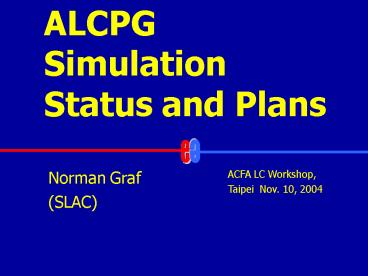LCD Analysis with JAS and ROOT - PowerPoint PPT Presentation
Title:
LCD Analysis with JAS and ROOT
Description:
Wizard will create outline of analysis, and can include sample analysis code. ... Ability to read detector constants from 'zip' file ... – PowerPoint PPT presentation
Number of Views:59
Avg rating:3.0/5.0
Title: LCD Analysis with JAS and ROOT
1
(No Transcript)
2
Outline
- Detector Simulation
- Hit Digitization
- Event Reconstruction
- Event Analysis
- LCIO, JAS3 Visualization
- org.lcsim reconstruction code
3
Detector Simulation
- Geant4 now default production engine.
- Strong support from SLAC Geant4 team ideas bug
fixes. - xml file format used as Geant4 input for
flexibility and ease of construction. - Improving some standard designs (SiD Big).
- Simulating more realistic detector elements.
- Others easily generated by users or upon request.
- LCIO now default output format.
- lcdg4 (NICADD) writes sio and lcio files using
existing detector xml description. - lcs (SLAC) writes lcio files, upgrade platform.
4
Updated Geometries
- Can define n-sided detectors.
- User-defined slicing of stave modules.
- Developing new xml schema for geometries.
5
Slicing
- Arbitrary slicing of subdetector staves.
- e.g. SiD Si/W EMcal.
- Could also use for hybrid Si/Sci.
6
Hit Digitization
- Calorimeter information quantized at Geant4
stage. Digitization package being developed. - Tracker information requires post-processing.
- Enables studies of detector strip, pixel sizes,
charge sharing, electronic noise, etc. - Provides more realistic simulation of effects of
backgrounds and noise - Nearby hits merged
- Hit-specific measurement uncertainties.
- Ghosts.
7
CCD Digitization (N. Sinev)
- VXD hits from simulated events, finds charge
deposited in each pixel, adds electronics noise
and digitizes signal. - Finds CCD clusters, splitting if necessary.
- Coordinates of found centers are used to replace
tracker hits in the simulated events. Further
event processing (track finding, fitting, and so
on) proceeds the same way as it was before. - Can set CCD parameters (like thickness, depleted
layer depth, epitaxial layer thickness and so
on), electronics parameters (noise, ADC
conversion scale, pixel and cluster thresholds),
processing parameters (like cluster center
calculation method). - hep.lcd.mc.CcdSim released.
8
TPC Digitization D. Peterson
Create hits, with time and pulse height,
centered on the average position in the cell
Wave Form to simulate time ( Z) response
Gaussian charge spreading on the pads
Threshold crossings found in this procedure
replace the original pad signals.
9
Si ?strip
- Digitization package which generates charge
sharing among strips and readout noise developed. - Several efforts devoted to tiling studies of
subdetectors. - Allows occupancies to be studied as functions of
strip lengths, orientation, charge sharing, and
ghosting due to stereo strip associations. - Electronics noise also being incorporated.
- Studying long vs short readouts.
10
Tiling Forward Disks
Wedges
Hexagons
11
Event Reconstruction Tracking
- Quite a bit of effort being devoted to developing
and improving track finding - Forward Tracking code implemented.
- VXD standalone tracking developed (N. Sinev)
- works even in presence of full backgrounds!
- Barrel track finding for SiD being developed
- inside-out (S. Wagner)
- outside-in (E. von Toerne, D. Onoprienko)
- TPC tracking being improved on (D. Peterson)
12
Event Analysis
- Aim is to demonstrate full Particle Flow
reconstruction. - ReconstructedParticle concept and example
implementation being implemented. - Several groups now working on various aspects
- Finishing up ?-finding high priority.
- Refining track-cluster association.
- Forward tracking code released.
- Muon-finding software actively worked on.
13
LCIO plugin for JAS3
- Works with any LCIO file
- Diagnostic tools allow to step through and view
events
14
LCIO plugin for JAS3
- Event Analysis
15
WIRED with LCIO Plugin
16
org.lcsim Goals
- Retain core functionality from hep.lcd package
- Full suite of reconstruction and analysis tools
available to all LCIO users - Update to use LCIO for IO and as basis for
simulation, raw data and reconstruction event
formats. - Update/simplify framework using experience from
hep.lcd - Internationalization
- Try to make package independent of detector
geometry assumptions so can work with any
detector - Read properties of detectors at runtime
- Update to Java 1.4 (or 1.5)
- Many improvements since hep.lcd framework was
created. - Ability to run standalone or in JAS3
- Revitalize work on reconstruction algorithms
17
org.lcsim Status
- Physics Utilities - done
- stdhep reader
- 3, 4-vector utilities
- diagnostic generator
- Jet finder, event shape utilities
- Org.lcsim package Phase I
- Conditions framework done
- Ability to read detector constants from zip
file - To define new detector just create new zip file
and place on web - File is read and cached locally
- Driver framework done
- Fast MC done
- IO Framework working.
- Event Display interface in progress
18
Necessary RD
- Many of the tools necessary for characterizing
detector designs exist - fast and flexible detector response simulation
- signal background samples and merging code
- detector digitization, hit merging
- track and calorimeter cluster reconstruction
- various parts of Particle Flow reconstruction
exist - Aim to release full package by LCWS05.
- Explore detector phase space prior to Snowmass.
- Need more people to use and develop!
19
Summary
- Significant progress during the last months.
- GEANT4 established as default.
- LCIO reco event model released.
- Much progress in tracker detector digitization.
- Track finding strategies being applied to
different topologies. - The developer/user community is growing there
is rapid progress in developing reconstruction
algorithms, especially Particle Flow.
20
Simulation Workshop Series
- NIU, SLAC, and ANL to-date.
- Several days of talks, meetings and tutorials.
- Two dozen participants.
- Propose to host an international version at SLAC
prior to LCWS05.
21
Greetings from Simulation Workshop III !
22
Lets make it happen!
23
Links
- LCIO http//lcio.desy.de
- hep.lcd http//www-sldnt.slac.stanford.edu/jas/Do
cumentation/lcd/ - Tutorials
- http//jas.freehep.org/jas3/Tutorial/index.html
- http//www-sldnt.slac.stanford.edu/snowmass/Welcom
e.html - JAS3 http//jas.freehep.org/jas3
- WIRED http//wired.freehep.org/
- HepRep http//heprep.freehep.org/
- Discussion Forums
- http//forum.linearcollider.org































